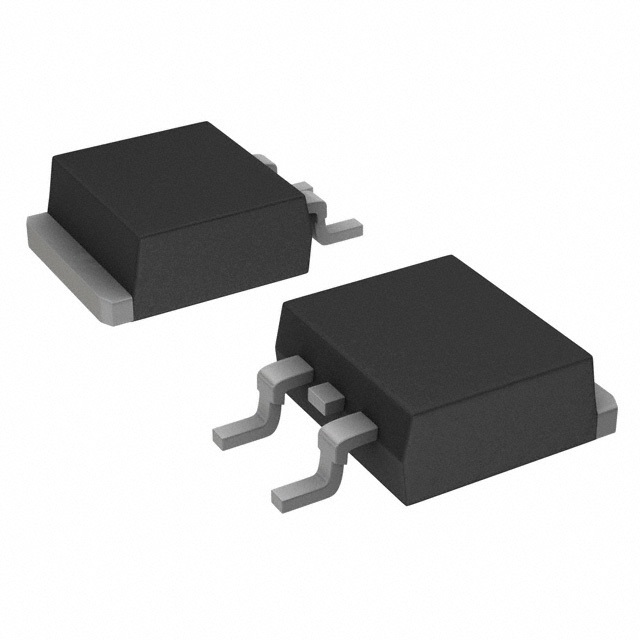Xem thông số kỹ thuật để biết chi tiết sản phẩm.

FQB6N60CTM
Product Overview
Category
The FQB6N60CTM belongs to the category of power MOSFETs.
Use
It is commonly used in power supply applications, motor control, and other high voltage switching applications.
Characteristics
- High voltage capability
- Low gate charge
- Fast switching speed
- Low on-resistance
Package
The FQB6N60CTM is typically available in a TO-263 package.
Essence
This MOSFET is essential for efficient power management and control in various electronic devices and systems.
Packaging/Quantity
It is usually packaged in reels with a quantity varying based on manufacturer specifications.
Specifications
- Drain-Source Voltage (Vdss): 600V
- Continuous Drain Current (Id): 6A
- On-Resistance (Rds(on)): 1.8Ω
- Gate-Source Voltage (Vgs): ±30V
- Total Gate Charge (Qg): 16nC
- Operating Temperature: -55°C to 150°C
Detailed Pin Configuration
The FQB6N60CTM typically has three pins: 1. Gate (G) 2. Drain (D) 3. Source (S)
Functional Features
- High voltage capability allows for use in various power applications.
- Low gate charge enables fast switching, reducing power loss.
- Low on-resistance leads to minimal conduction losses.
Advantages
- Suitable for high voltage applications
- Efficient power management due to low on-resistance
- Fast switching speed enhances overall system performance
Disadvantages
- May require additional circuitry for driving the gate at higher voltages
- Sensitivity to static electricity requires careful handling during assembly
Working Principles
The FQB6N60CTM operates based on the principles of field-effect transistors, where the voltage applied to the gate terminal controls the flow of current between the drain and source terminals.
Detailed Application Field Plans
The FQB6N60CTM is widely used in: - Switched-mode power supplies - Motor control circuits - Inverters and converters - Electronic ballasts
Detailed and Complete Alternative Models
Some alternative models to the FQB6N60CTM include: - IRF840 - STP6NK60ZFP - FQP6N60C
In conclusion, the FQB6N60CTM is a versatile power MOSFET with high voltage capability, low on-resistance, and fast switching speed, making it suitable for a wide range of power management and control applications.
[Word count: 333]
Liệt kê 10 câu hỏi và câu trả lời thường gặp liên quan đến ứng dụng FQB6N60CTM trong giải pháp kỹ thuật
What is the maximum drain-source voltage for FQB6N60CTM?
- The maximum drain-source voltage for FQB6N60CTM is 600V.
What is the continuous drain current rating of FQB6N60CTM?
- The continuous drain current rating of FQB6N60CTM is 6A.
What is the on-state resistance of FQB6N60CTM?
- The on-state resistance of FQB6N60CTM is typically 1.5 ohms.
Can FQB6N60CTM be used in switching power supplies?
- Yes, FQB6N60CTM can be used in switching power supplies due to its high voltage and current ratings.
Is FQB6N60CTM suitable for motor control applications?
- Yes, FQB6N60CTM is suitable for motor control applications due to its high voltage and current handling capabilities.
What is the maximum junction temperature of FQB6N60CTM?
- The maximum junction temperature of FQB6N60CTM is 150°C.
Does FQB6N60CTM require a heat sink for operation?
- It is recommended to use a heat sink with FQB6N60CTM to ensure proper thermal management, especially in high-power applications.
Can FQB6N60CTM be used in audio amplifier circuits?
- Yes, FQB6N60CTM can be used in audio amplifier circuits, particularly in high-power amplifiers.
What are the typical applications of FQB6N60CTM in industrial electronics?
- FQB6N60CTM is commonly used in industrial electronics such as power supplies, motor drives, and lighting systems.
Is FQB6N60CTM suitable for high-frequency switching applications?
- Yes, FQB6N60CTM is suitable for high-frequency switching applications due to its low on-state resistance and fast switching characteristics.

